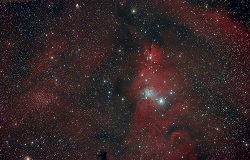A cleaner universe as newly born stars absorb cosmic dust
Researchers at the University of Cardiff, UK, part funded by the European Research Council (ERC) under the COSMICDUST project, have used the Herschel space telescope to peer back 12 billion years and observe the very early formation of galaxies and compare them to galaxies that have formed much more recently. The results showed them that stars were forming inside galaxies much faster in the past compared to today, and that this rapid star birth is using up more and more of the cosmic dust that is spread throughout the universe. Cosmic dust is comprised of tiny solid particles that are found everywhere in space between the stars, and along with gas, are the raw materials from which stars and galaxies form. The research has shown that even only one billion years in the past, a small fraction of the age of the universe, galaxies were forming stars faster and contained more cosmic dust than galaxies today. Although this blanket of material is crucial for the formation of stars and galaxies, it also acts as a sponge, absorbing almost half of the light emitted by stellar objects and making them impossible to observe using standard optical telescopes. Launched in 2009, the Herschel space telescope provides astronomers with the perfect tool for probing the hidden universe. Possessing a collection of sensitive instruments, mirrors and filters, the telescope was able to detect the dust through the far-infrared emission it emits, revealing the existence of stars and galaxies hidden by the dust. Professor Haley Gomez, one of the project leads, presented the team’s results on 29 June at the British National Astronomy Meeting in Nottingham, UK. The research team has now released a large catalogue of the sources of far-infrared radiation in this ‘hidden universe’. The team’s survey of the sky, called the Herschel Astrophysical Terahertz Large Area Survey (Herschel ATLAS) has revealed the details of over half a million galaxies, many of which have been as they were over 12 billion years ago, only shortly after the Big Bang. Moving forward, the team hope that this extensive catalogue will become a vital tool for astronomers hoping to understand the detailed history of galaxies and the wider cosmos. Published in the journal ‘Monthly Notices of the Royal Astronomical Society’, Dr Elisabetta Valiante, one of the lead authors, commented: ‘The exciting thing about our survey is that it encompasses almost all of cosmic history, from the violent star-forming systems full of dust and gas in the early universe, that are essentially galaxies in the process of formation, to the much more subdued systems we see around us today.’ Dr Loretta Dunne, another prominent member of the research team also commented: ‘Before Herschel we only knew of a few hundred such dusty sources in the distant universe and we could only effectively 'see' them in black and white. Herschel, with its five filters, has given us the equivalent of technicolour, and the colour of the galaxy tell us about their distances and temperatures. So we now have half a million galaxies we can use to map out the hidden star formation in the universe’. The COSMICDUST project will continue until August 2020 and has received around EUR 1 800 000 in EU funding. For more information please see: project page on CORDIS
Countries
United Kingdom



